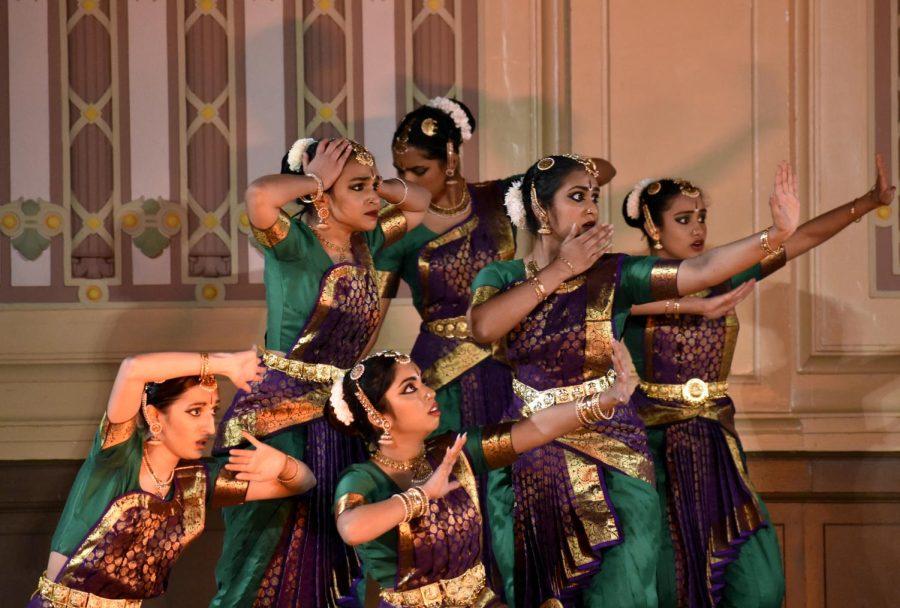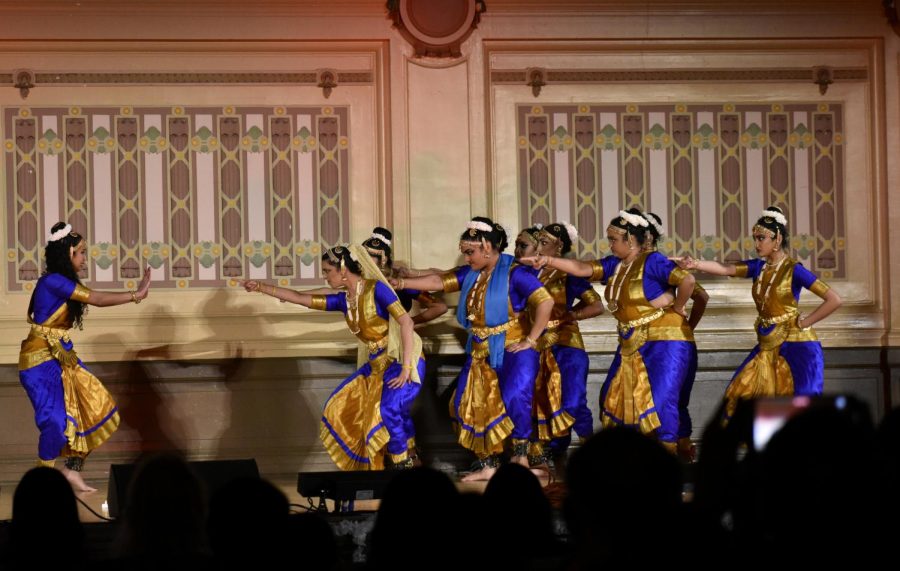10th annual Dhirana competition explores multiple styles of Indian dance
Romita Das | Senior Staff Photographer
Dancers from the group GT Pulse perform at the 10th annual Dhirana competition at Soldiers & Sailors Memorial Hall and Museum on Saturday.
February 20, 2022
Silence seeped into every crevice of the auditorium as the crowd watched Medusa’s fate descend upon her, with dancers maneuvering their limbs to replicate the body of a slithering snake. Eyes wide and locked on their target, the dancers lurched forward, turning their victims to stone.
The rendition of an ancient Greek myth was a part of last week’s Dhirana dance competition. The eponymous student-run organization, dedicated to promoting the art of Indian classical dance, hosted its 10th annual competition on Saturday at Soldiers & Sailors Memorial Hall and Museum. More than 200 parents and students attended the competition in person, with another 1,000 viewers watching via YouTube livestream.
Before the teams performed, the story behind each dance was introduced in a video presentation. The GT Pulse won first place with a dance that retold the story of Medusa and Perseus. Dressed in green and purple, the team emulated many aspects of the story. To show their dedication to the performance, a dancer put a blindfold on at one point to imitate Perseus killing Medusa.
Dhirana, a common word used in Indian rhythmic classical dance pieces, was created at Pitt by members of Pitt’s Indian classical dance team, Nrityamala, after the University hosted Laasya, a traveling Indian classical dance competition, in 2012. According to Dhirana’s website, the Nrityamala dancers were unhappy to see the competition leave campus and created a competition that Pitt could host annually.
All proceeds from the competition go to the Birmingham Free Clinic, which provides free medical care for underserved Pittsburghers. Mary Herbert, BFC’s clinical director, spoke on stage about how BFC is the longest-running free clinic in southwestern Pennsylvania, and Dhirana is the single largest individual donor in its history — raising $105,000 since the partnership began.
Mythri Sundar, co-director of Dhirana and a senior urban studies major, said the organization is constantly staying active by engaging in other events.
“We use the full year after the show to prepare for the next one,” Sundar said. “We also stay active with fundraisers and collaborations with other organizations … Over the course of the year, they’ll be working on getting all show preparations into place, reaching out to businesses and organizations, dance teams … and many more people who are essential to making Dhirana successful.”
Teams from colleges around the country come each year to compete alongside Pitt’s host team, and the eight teams this year hailed from Texas, Florida, Maryland and more. The first team on stage was UTD Rangam, who retold the Greek myth of Pandora’s Box during their dance.
The dancers were adorned in an array of colors ranging from black and orange to white and purple. The dresses — called saris, a traditional garment worn in Desi culture — are important in highlighting each dancer’s abilities on stage, according to Nrityamala co-captain Krishna Nayak.
“We want to preserve the traditions behind the art while showcasing it to a contemporary audience,” Nayak, a sophomore neuroscience and economics major, said. “The costumes enhance the performance and allow us to connect to the audience and the dancer within us.”
Although the competition focused on forms of Indian classical dance — such as Bharatanatyam, Kathak and Kuchipudi — there were exhibition acts by multiple groups. CMU Bhangra took to the stage and performed an Indian folk dance, in comparison to the storytelling of classical dance.
Avaaz, Pitt’s South Asian acapella group, performed a medley of English and Hindi songs. Meghana Dodda, an Avaaz singer, said the nerves got to her at first, but she was ready to perform once on stage.
“It gets scarier the closer the performance gets, so standing backstage was a lot more stressful,” Dodda, a first-year neuroscience major, said. “There was definitely like a hint of nervousness, but everybody was excited to perform.”
Nrityamala co-captain Mansi Avunoori said she appreciated being able to express the beauty of her culture and share it with others.
“We feel this immense sense of pride,” Avunoori, a sophomore biology major, said. “We are able to create something new while preserving a cultural tradition that is a millennium old. It’s great to connect to our heritage while also promoting appreciation of our art form to a diversified community.”
Rucha Lovalakar, a high school student from nearby Franklin Park who came to see the show, said Dhirana shows her how she can further her own learning in Bharatanatyam, for which she is currently taking classes.
“I think it’s nice because you can see that it’s not just a class you can take as you’re growing up that won’t lead to anything,” Lovalakar said. “It’s nice to see that colleges and organizations can keep it alive because then, even in college, you can join such a team knowing there’s still a future with it.”
Shreya Babu, Dhirana’s registrations chair and a junior majoring in sociology and administration of justice, said she hopes Dhirana’s objective and ambition are shown through the expression of dance.
“I hope that after viewing or participating in Dhirana, people fully appreciate both of our aims …,” Babu said. “Whether your connection to Dhirana is that of a performer, board member, or supporter, we come together with relentless dedication for an important cause through the vehicle of dance.”









